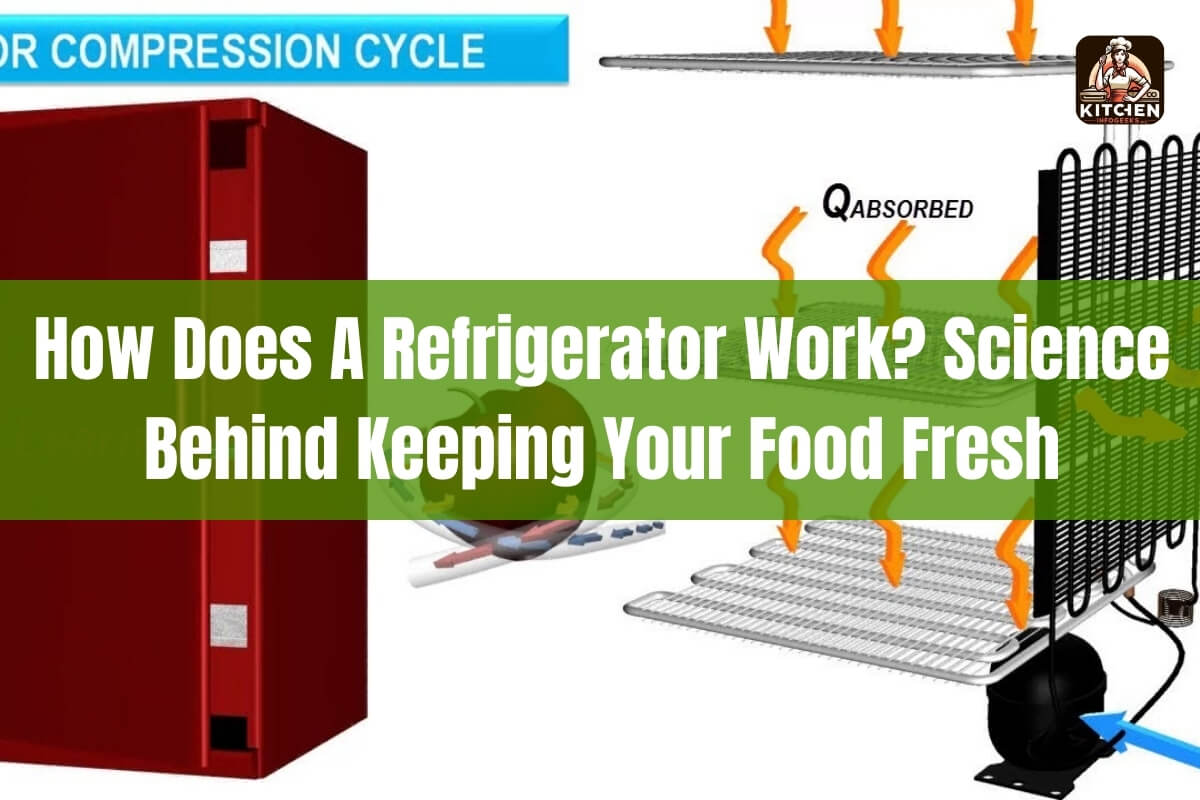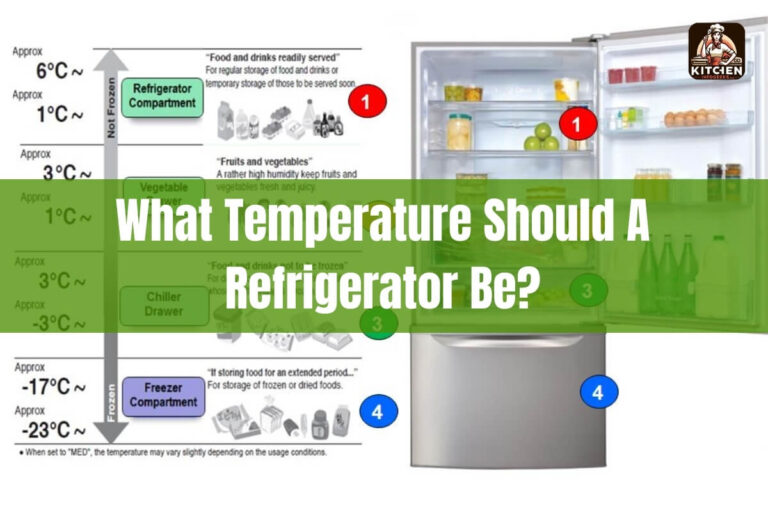
Have you ever wondered how your refrigerator manages to keep your food and beverages cold and fresh? It may seem like a simple appliance, but there’s some fascinating science at work behind the scenes. In this comprehensive guide, we’ll dive deep into how a refrigerator works, exploring the various components and the underlying principles that enable this essential household appliance to maintain cool temperatures.
The main goal of a refrigerator is to remove heat from an insulated compartment, creating a colder environment that slows down bacterial growth and preserves the freshness of your perishable items. But how does it achieve this feat? We’ll cover everything from the refrigeration cycle and thermodynamics to proper maintenance tips to ensure your fridge operates efficiently.
Here’s what we’ll explore in this article:
- The step-by-step refrigeration cycle that enables heat transfer
- The roles of key components like the compressor, condenser, evaporator, and expansion valve
- The scientific principles behind phase changes and ideal refrigerants
- Tips for maximizing your refrigerator’s efficiency and longevity
- Signs that your fridge may need repair or maintenance
So, let’s dive in and unravel the mystery of how this modern marvel manages to keep your food fresh and your beverages frosty!
The Refrigeration Cycle Step-by-Step
At the heart of every refrigerator lies a closed-loop system known as the refrigeration cycle. This cycle is a continuous process that transfers heat from the insulated compartment to the outside environment, maintaining a cooler interior temperature.
Here’s a breakdown of the refrigeration cycle and how it works:
1. The Compressor
The compressor is the powerhouse of the refrigeration cycle. Its primary role is to compress the refrigerant gas, increasing its pressure and temperature. This compressed, high-pressure gas is then pushed into the condenser coils.
2. The Condenser Coils
As the hot, compressed refrigerant gas enters the condenser coils, it begins to release its heat to the surrounding air. This heat dissipation causes the refrigerant to condense from a gas into a liquid state.
The condenser coils are typically located on the back or bottom of the refrigerator, where they can efficiently expel the absorbed heat into the surrounding room or outside environment.
3. The Expansion Valve
Once the refrigerant has condensed into a liquid, it passes through an expansion valve or capillary tube. This component acts as a bottleneck, causing a rapid decrease in the refrigerant’s pressure and temperature.
As the liquid refrigerant expands and cools, it transitions into a cold, low-pressure vapor or mist. This cold vapor is now ready to absorb heat from inside the refrigerator.
4. The Evaporator Coils
The cold, low-pressure refrigerant vapor enters the evaporator coils, which are located inside the insulated compartment of the refrigerator. As the vapor circulates through these coils, it absorbs heat from the surrounding air, causing it to cool down.
This heat absorption causes the refrigerant to evaporate, changing from a cold vapor back into a warm, low-pressure gas. This warm gas is then pulled back into the compressor, where the cycle begins again.
5. Completing the Cycle
As the warm, low-pressure refrigerant gas enters the compressor, it is compressed once more, increasing its pressure and temperature. This high-pressure, hot gas is then circulated back into the condenser coils, where it releases its heat to the outside environment, and the cycle continues indefinitely.
This continuous cycle of compression, condensation, expansion, and evaporation allows the refrigerator to maintain a consistent, cool temperature inside the insulated compartment, preserving the freshness of your food and beverages.
Refrigerator Components & Their Roles
While the refrigeration cycle is the driving force behind a refrigerator’s cooling capabilities, several key components play crucial roles in making this process possible. Let’s take a closer look at these components and their functions:
The Compressor
Often referred to as the “heart” of the refrigerator, the compressor is responsible for circulating the refrigerant through the system and compressing the gas to increase its pressure and temperature.
Compressors are typically powered by electric motors and can vary in size and capacity depending on the refrigerator model and cooling requirements.
The Condenser
The condenser is a series of coils or fins located on the back or bottom of the refrigerator. Its primary function is to dissipate the heat absorbed by the refrigerant during the compression process.
As the hot, compressed refrigerant gas passes through the condenser, it releases its heat to the surrounding air, causing it to condense into a liquid state. Fans or airflow channels help facilitate this heat exchange process.
The Evaporator
The evaporator is a crucial component responsible for creating the cold environment inside the refrigerator. It consists of a series of coils or plates that the cold, low-pressure refrigerant vapor passes through.
As the refrigerant evaporates inside the evaporator, it absorbs heat from the surrounding air, effectively cooling the interior of the refrigerator compartment.
Expansion Device (Capillary Tube or Expansion Valve)
The expansion device, typically a capillary tube or an expansion valve, plays a crucial role in regulating the flow of refrigerant and controlling the pressure drop between the condenser and evaporator.
By creating a bottleneck, the expansion device causes the liquid refrigerant to rapidly expand and cool, transitioning into a cold vapor ready to absorb heat in the evaporator.
Thermostat
The thermostat is the control mechanism that regulates the refrigeration cycle. It monitors the temperature inside the refrigerator and cycles the compressor on and off as needed to maintain the desired temperature range.
When the thermostat senses that the temperature has risen above the set point, it activates the compressor, initiating the cooling process. Once the desired temperature is reached, the thermostat turns off the compressor, allowing the cycle to pause until further cooling is required.
Refrigerator Science 101
While the refrigeration cycle and its components are essential for understanding how a refrigerator works, it’s also important to explore the underlying scientific principles that make this process possible.
Thermodynamics at Work
The refrigeration cycle is a prime example of the first and second laws of thermodynamics in action.
The first law of thermodynamics states that energy cannot be created or destroyed; it can only be transferred or transformed from one form to another. In the case of a refrigerator, the compressor uses electrical energy to increase the temperature and pressure of the refrigerant gas, which then transfers heat energy from the insulated compartment to the outside environment.
The second law of thermodynamics dictates that heat will naturally flow from a hotter object to a cooler object, but it cannot spontaneously flow in the opposite direction without the input of external work. This is where the compressor comes into play, providing the necessary work to move heat from the cooler interior of the refrigerator to the warmer outside environment.
Additionally, the refrigeration cycle relies on the phase changes of the refrigerant as it transitions between liquid and gaseous states. These phase changes involve the absorption or release of latent heat, which is the energy required for a substance to change its state without changing its temperature.
Ideal Refrigerants
For the refrigeration cycle to operate efficiently, the refrigerant used must possess specific properties. An ideal refrigerant should:
- Have a low boiling point to facilitate evaporation and absorption of heat at relatively low temperatures
- Have a high heat of vaporization to maximize the amount of heat absorbed during the evaporation process
- Be non-toxic, non-flammable, and environmentally friendly
- Be chemically stable and compatible with the materials used in the refrigeration system
Over the years, various refrigerants have been used in refrigerators, each with its own advantages and disadvantages. Early refrigerators used ammonia, which was effective but highly toxic. Later, chlorofluorocarbons (CFCs) became popular due to their non-toxic and non-flammable properties, but they were eventually phased out due to their contribution to ozone depletion.
Today, most modern refrigerators use hydrofluorocarbon (HFC) refrigerants, which have a lower environmental impact than CFCs but are still being phased out in favor of more environmentally friendly alternatives like hydrofluoroolefins (HFOs) and natural refrigerants like carbon dioxide and ammonia.
Maintaining an Efficient Refrigerator
While the science behind refrigeration is fascinating, it’s also important to understand how to maintain your refrigerator’s efficiency and longevity. Here are some tips to keep your fridge running smoothly:
Proper Temperature Settings
One of the most critical factors in maintaining an efficient refrigerator is setting the appropriate temperature. The recommended temperature range for most refrigerators is between 35°F and 38°F (1.7°C and 3.3°C) for the fresh food compartment and 0°F (-17.8°C) or below for the freezer compartment.
Keeping your refrigerator at the ideal temperature not only preserves the freshness and quality of your food but also helps the appliance run more efficiently. If the temperature is set too low, it can cause unnecessary energy consumption and potential freezing of items in the fresh food section. On the other hand, if the temperature is too high, it can lead to faster spoilage and the growth of harmful bacteria.
It’s essential to periodically check the temperature inside your refrigerator and adjust the settings as needed. Most modern refrigerators have built-in temperature controls or displays that make it easy to monitor and adjust the temperature.
Allow Proper Airflow
Proper airflow is crucial for efficient refrigerator operation. Overcrowding or blocking the air vents inside the compartments can restrict the circulation of cold air, leading to uneven cooling and increased energy consumption.
To ensure proper airflow, avoid overstuffing your refrigerator and freezer compartments. Leave some space between items to allow the cold air to circulate freely. Additionally, make sure not to block the air vents with food items or other obstructions.
Periodic Cleaning
Regular cleaning and maintenance can go a long way in ensuring your refrigerator operates at peak efficiency. Over time, dust and debris can accumulate on the condenser coils, hindering their ability to dissipate heat effectively.
It’s recommended to clean the condenser coils at least once a year to remove any buildup. Consult your refrigerator’s manual for specific instructions on how to access and clean the condenser coils safely.
Additionally, keep the interior of your refrigerator clean by wiping down shelves and drawers regularly. This helps prevent the buildup of spills and odors, which can affect the freshness of your food.
Watch for Signs of Issues
Like any appliance, refrigerators can develop issues over time. Being vigilant and addressing problems early can save you from costly repairs or replacements down the line.
Some signs that your refrigerator may need attention include:
- Excessive noise or unusual sounds
- Warm temperatures or uneven cooling
- Condensation buildup or ice accumulation
- Leaks or water pooling
- Increased energy consumption
If you notice any of these issues, it’s best to have a professional technician inspect and service your refrigerator to identify and resolve the underlying problem.
By understanding how a refrigerator works, the scientific principles behind its operation, and the importance of proper maintenance, you can ensure that your appliance continues to keep your food fresh and your beverages chilled for years to come.






